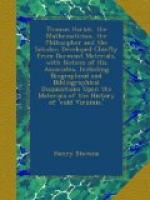de/ MORGVES Paintre.’/ This dedication is dated ’ Londres/ ce xxvi. de Mars.’/ On the reverse of the second leaf, also in French, is ’ ¶ A Elle Mesme,/ Sonet’ with the initials I.L.M.
Then follow forty-eight leaves with two woodcuts coloured by hand on the recto of each leaf, reverse blank. These ninety-six cuts sum up twenty-four each of beasts, birds, fruits and flowers, with names printed under each in English, French, German and Latin. Although the book is dated the 26th of March 1586, it was not entered at Stationers’ Hall until the 31st of July 1587. It there stands under the name of James Le Moyne alias Morgan. Madame Sidney is given as Mary Sidney. She was sister of Sir Philip, countess of Pembroke, ’ Sidney’s sister, Pembroke’s mother.’ There is no allusion to Sir Philip in the dedication, and therefore we may infer that it was penned before the battle of Zut-phen. Both the dedication and the sonnet show the artist’s intimacy and friendship with that distinguished family.
There are two copies of this exceedingly rare book in the British Museum, both slightly imperfect, but will together make a complete one, but the more interesting copy is that in 727 c/2 31, in the Sloane Collection. It has bound up with it thirty-seven leaves on which are beautifully drawn and painted flowers, fruits, birds &c. There can be little doubt that these are Le Moyne’s own paintings. It is curious to find that all these scattered works in the different departments came in with the Sloane Collection which formed the nucleus of the British Museum. It is to be hoped that other samples of Le Moyne’s art may be found or identified, and that all of them may be brought together or be described as the ’ Le Moyne Collection.’ How Sir Hans Sloane became possessed of them does not yet appear.




